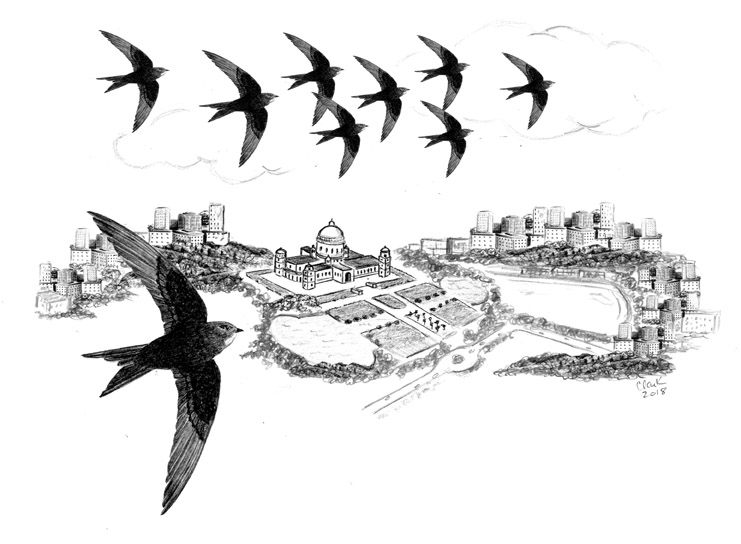
Dear Bird Folks,
We discovered a small flock of Common Swifts flying just before dusk. We love to watch them, but we don’t see them during the day. We are curious to know why the swifts only fly at dusk.
– Somnath, Kolkata, India
Hold on, Somnath,
Did you say you are from India? Not Indiana or Indianapolis, but India-India, the land of vegetarians, tigers, temples and tech support? Wow! I’ve never received a question from India before. I’m totally flattered and am going to try extra hard with your answer. There is just one problem. I don’t know anything about your birds, except maybe the peacock, but that’s mostly from watching TV shows on NBC. No worries, though. I have a lot of books, which I’m sure will have an answer to your question. Besides, I should learn more about your country. I may travel there someday to check out the birds, visit the temples…and get my laptop fixed.
Before I begin, here’s an interesting factoid. From a distance, or even up close, swifts and swallows look and act very much alike. Both birds spend their day gliding through the air and scooping up insects. But surprisingly, the two species aren’t closely related. Instead of being cousins, swifts are actually more closely related to, of all things, hummingbirds. And believe it or not, the reason for the hummingbird/swift relationship has nothing to do with a love of flowers or nectar. Instead, it’s about wing structure. Okay, maybe it wasn’t all that “interesting,” but it was still a factoid.
Like the Chimney Swifts we have here in North America, Common Swifts historically have nested in natural cavities. But in recent centuries the birds have found human habitat to be more to their liking. In a rare instance of development helping birds, the swifts have adapted to nesting in the cracks and cavities in manmade structures. And in some locations, people have installed specially designed birdhouses, which the swifts readily accept. Hey, that sounds like an opportunity. Maybe I should open a birding shop in Kolkata. Although, the commute could be a problem. I’ll have to look into that.
When the male swift arrives in the spring (from Africa), he immediately claims his old nest site. He is obsessed with last year’s nest and will fight to keep all other intruders away, including females. Eventually though, a brave female will tentatively enter the cavity and if he strokes her chin, it’s all good. But the female shouldn’t get too comfortable in the relationship. He often spends less time defending her and more time protecting his nesting cavity (like a middle-aged American male with a Corvette).
Common Swifts are gregarious birds and frequently nest in colonies of up to forty pairs. That’s good, since swifts eat a lot of nasty insects. However, if your house has enough cracks and crevices to support eighty swifts, your property probably needs a bit of maintenance. Folks who are lucky enough to have swifts nesting in their building will likely see something very few other people ever get to see, a Common Swift land. Swifts love to fly, only stopping long enough to raise a family. The rest of the year they remain aloft, without ever landing. Really. That means they eat, drink, sleep and even mate on the wing, making swifts the founding members of the Mile High Club.
How do we know swifts never land? For years researchers were baffled by the fact that they couldn’t find any swifts roosting on their wintering grounds. They suspected the birds may remain in the air continuously, but could never prove it. Then the iPhone came out. No, they didn’t call the birds or try to text them. But those tiny accelerometers, which allow us to play games on our phones, were affixed to migrating swifts. From the time the birds left their breeding grounds, until the moment they returned in the spring, which was ten months later, the accelerometers never stopped moving and the birds never stopped flying. (However, their cell phone bills were huge.)
This brings us to your question: If the swifts are always flying, why do you only seeing them at dusk? I’ll explain my theory with a story. There once was a time when I coached Little League baseball. (Baseball is a game like cricket, only a lot less British.) As you might have expected, I would keep one eye on the game and one eye on whatever birds were passing overhead. At sunset, the area over the field became filled with Chimney Swifts. This happened so often that I simply assumed the swifts only came out in the evening. I later learned this wasn’t true. Chimney Swifts are active all day, but often they are simply flying too high to be seen. Why did they come to this field in the evening? Probably for the same reason you see your birds at dusk…for food. Insects tend to “come out” when it starts getting dark. Also, many flying insects are especially attracted to artificial lights, even city lights. I’m not saying your neighborhood has a lot of bugs…but the swifts might be.
I’m honored that you wrote to me, Somnath. I hope to travel to India someday. It would be great to see some of your birds, to be among so many fellow vegetarians and perhaps to go for a hike in the jungle and get a glimpse of a tiger. Tigers are also vegetarians, right? Oh, I’m sure they are.